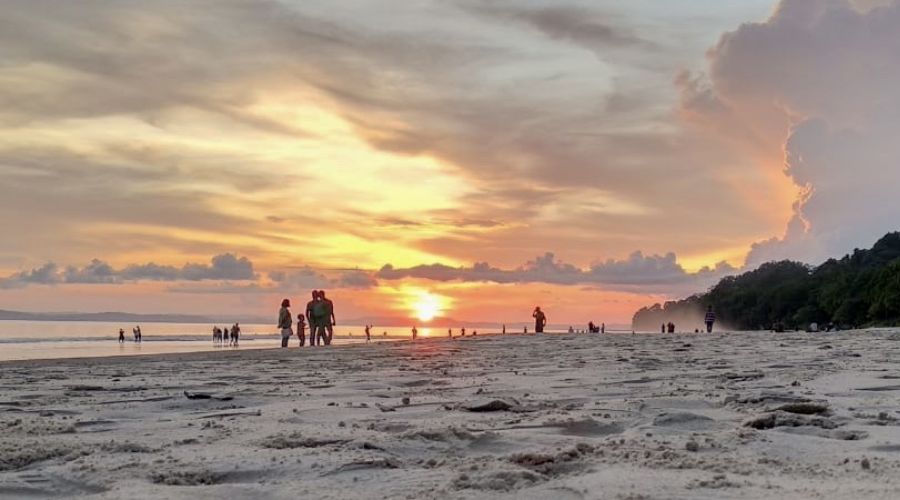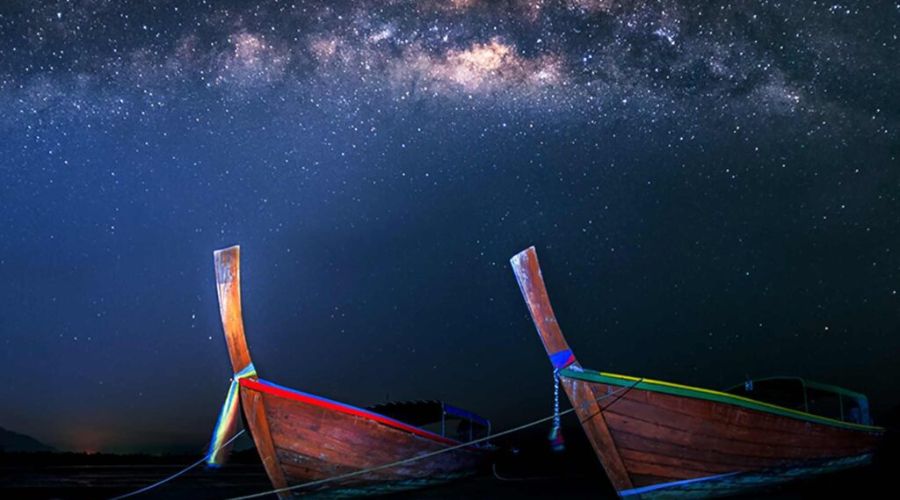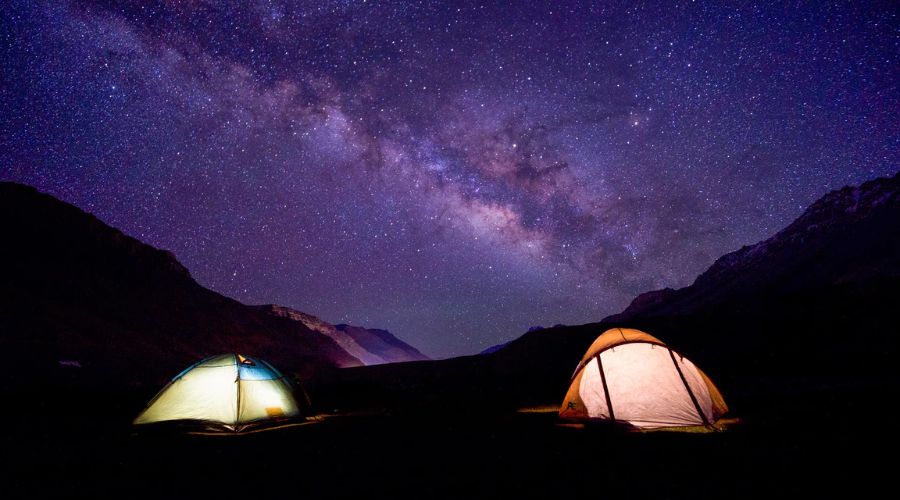Dark Sky Tourism and Stargazing Experiences in Andaman and Nicobar Islands
The Andaman and Nicobar Islands offer incredible opportunities for dark sky tourism and stargazing experiences due to their remote location and minimal light pollution. The clear, unpolluted skies make it an ideal destination to observe celestial wonders, from shimmering constellations to the Milky Way’s breathtaking display. Popular spots like Neil Island, Havelock Island and Radhanagar Beach provide tranquil settings for stargazing enthusiasts. Visitors can also enjoy night-time photography, guided star-watching sessions and even learn basic astronomy. The serene ambience of the islands combined with the vast night sky creates a magical experience for nature lovers and stargazers alike. The serenity, the magic of the dark sky glittering with infinite stars create a fairy-tale charm that is ethereal.
Suggested Read: Travel tips for Andaman and Best time to Visit Andaman
Why Andaman and Nicobar for Astro Tourism?

The Andaman and Nicobar Islands are a perfect destination for astro tourism due to their remote location, minimal light pollution and pristine natural environment. Being far from urban centres, the islands offer some of the darkest skies in India, ideal for observing celestial phenomena such as constellations, the Milky Way and meteor showers. The tropical climate ensures relatively clear skies during most of the year, particularly between November and March. Additionally, the islands’ tranquil beaches and scenic landscapes enhance the stargazing experience, making it both visually stunning and deeply relaxing. The combination of unique geography, clear skies and natural beauty makes Andaman and Nicobar an unparalleled destination for astro enthusiasts.
Suggested Read : Andaman tour packages
Key Existing Astro Spots in South Andaman

Science Centre (Port Blair)
The Science Centre in Port Blair is a hub of interactive learning and exploration, designed to ignite curiosity and promote understanding of science among visitors. Situated amidst lush greenery, this centre features engaging exhibits, including displays on marine biodiversity, volcanic activities and the unique geography of the Andaman and Nicobar Islands. A highlight is its demonstration of the principles of science through interactive models and exhibits. Such a location is ideal for astro spot and astro tourism.
Visitors can explore a variety of galleries that showcase the islands’ ecological and cultural richness, along with displays explaining astronomical phenomena and Earth’s geological formations. The Science Centre also conducts workshops and activities for children, making it an educational and enjoyable destination for families. Its serene location and informative exhibits make it a must-visit attraction for those keen on learning about the natural and scientific wonders of the region.
Suggested Read : Best time to visit andaman
How to Reach the Science Centre in Port Blair
The Science Centre is located in Port Blair, the capital of the Andaman and Nicobar Islands, making it easily accessible.
From Veer Savarkar International Airport:
- The Science Centre is approximately 4 km from the airport.
- You can take a taxi, auto-rickshaw, or even rent a two-wheeler to reach the centre within 10–15 minutes.
From the Port Blair City Centre:
- It is situated around 3 km from the main city centre.
- Local transport options like buses, autos, or shared cabs are readily available.
By Ferry (for visitors from other islands):
If you’re coming from nearby islands like Havelock or Neil, ferries will drop you at the Port Blair jetty. From there, the Science Centre is a short 10–15 minute ride via taxi or auto.
The centre’s convenient location and proximity to other attractions in Port Blair make it an easy addition to any travel itinerary.
Suggested Read : Activities to do in andaman
Whistlingwoods (Beodnabad)

Whistling Woods, located in Beodnabad, is a serene and picturesque eco-retreat in Port Blair, offering visitors a tranquil escape surrounded by lush greenery and stunning natural beauty. It is an emerging destination known for its blend of modern amenities and a close connection to nature, making it perfect for travellers seeking peace and rejuvenation.
This location features activities like nature walks, birdwatching and stargazing, catering to eco-tourism enthusiasts. It is currently enjoying a lot of attention due to the mushrooming astro tourism. Its strategic setting amidst the pristine Andaman environment also provides a vantage point for breathtaking sunrise and sunset views. Whistling Woods is also popular for its cozy accommodations, which harmonize with the natural surroundings, making it ideal for solo travellers, couples and families.
Whether you’re looking for a place to unwind or explore the region’s natural treasures, Whistling Woods in Beodnabad offers a serene and enriching experience.
Suggested Read : holiday in andaman
How to Reach Whistling Woods (Beodnabad)
Whistling Woods is located in Beodnabad, just a short distance from Port Blair, making it easily accessible.
From Veer Savarkar International Airport, Port Blair:
- Distance: Approximately 10 km.
- Travel Time: Around 20–30 minutes by road.
- Transport Options: Taxis and auto-rickshaws are readily available outside the airport. You can also opt for private cabs or bike rentals for convenience.
From Port Blair City Centre:
- Distance: Around 12 km.
- Travel Time: Roughly 30 minutes by road.
- Transport Options: Local buses, shared autos and private vehicles can take you to Beodnabad.
From Ferries/Port Area:
- If you are arriving from another island like Havelock or Neil, you can take a ferry to Port Blair. From the jetty, Whistling Woods is about a 12–15 km ride, and you can hire a taxi or auto to reach it.
The roads leading to Whistling Woods are scenic, offering glimpses of the island’s lush greenery, making the journey enjoyable and relaxing.
Suggested Read : Rangat middle andaman
Kodiyaghat

Kodiyaghat, located on the outskirts of Port Blair in the Andaman Islands, is a serene and lesser-known destination known for its natural beauty and tranquil environment. It is a perfect spot for nature lovers and solitude seekers. This picturesque location boasts a rocky shoreline, pristine waters and lush greenery, making it an ideal getaway for anyone looking to escape the busy tourist spots. This natural beauty of the surroundings add to the thrill and perfection of astro tourism.
Kodiyaghat is particularly famous for its spectacular sunrise views, offering visitors a mesmerizing experience in the early morning hours. The area is also home to unique flora and fauna, making it a great spot for nature walks and bird watching. Additionally, the place is popular among photography enthusiasts due to its dramatic landscapes and seascapes. While there are no major water sports here, visitors can explore the tidal pools along the shore and enjoy peaceful moments by the sea. Its untouched beauty makes Kodiyaghat a hidden gem for those looking to connect with nature in its purest form.
Suggested Read : Migratory birds of andaman island
How to Reach Kodiyaghat
Kodiyaghat is located approximately 15 km from Port Blair, making it an easy and scenic destination to visit.
From Veer Savarkar International Airport, Port Blair:
- Distance: About 15 km.
- Travel Time: Around 30–40 minutes by road.
- Transport Options: You can hire a taxi or rent a bike for the journey. Auto-rickshaws are also available for local travel.
From Port Blair City Center:
- Distance: Around 12–15 km, depending on your starting point in the city.
- Travel Time: Approximately 30 minutes by road.
- Transport Options: Taxis, private cabs and bike rentals are readily available. For budget-friendly options, you can use local buses heading in that direction.
Route Details:
- Take the road leading to Chidiya Tapu, as Kodiyaghat lies en route to this popular destination. The drive itself is scenic, with views of lush forests and coastal landscapes.
Nearest Ferry Terminal:
- If you’re arriving at Port Blair via ferry, Kodiyaghat is a short ride from the jetty. Hire a taxi or rent a vehicle to reach the location.
The approach to Kodiyaghat involves some winding roads and forested areas, adding to its charm. It’s advisable to travel during daylight hours to enjoy the views and ensure a safe journey.
Suggested Read : Best forest trails in andaman
Proposed Astro Spots

The Andaman and Nicobar Islands, with their minimal light pollution and pristine skies, are emerging as a destination for astrotourism. These proposed astro spots provide breathtaking opportunities for stargazing and celestial observations. Here are some key proposed locations:
Neil Island (Shaheed Dweep)
Known for its clear skies, away from the hustle of city lights, Neil Island offers an excellent location for observing stars and constellations. Its tranquil beaches, such as Bharatpur and Sitapur, become ideal spots for nighttime stargazing.
Havelock Island (Swaraj Dweep)
Radhanagar Beach, famous for its beauty during the day, transforms into a magical spot for stargazing at night. The lack of artificial lights and the open horizon make it perfect for observing the Milky Way and shooting stars.
Suggested Read : Seafood cuisine in andaman
Chidiya Tapu
Located about 25 km from Port Blair, Chidiya Tapu is not only a birdwatcher’s paradise but also a proposed site for stargazing. The sunset point, with its unobstructed view of the horizon, offers a great vantage for astrophotography.
Mount Harriet National Park
As one of the highest peaks in the Andaman Islands, Mount Harriet provides a high-altitude location with minimal atmospheric interference for celestial observations.
Rangat and Baratang Mangroves
These less-explored locations in the Middle Andamans offer serene, dark skies for astrotourism. The remoteness of the mangroves ensures minimal light pollution, making it an ideal location for night-sky enthusiasts.
Little Andaman
Little Andaman, particularly Butler Bay Beach, is being explored as a potential astrotourism hub due to its untouched and isolated landscapes.
Ross and Smith Islands
Famous for their unique sandbar connection, these twin islands in North Andaman provide unparalleled views of the night sky, perfect for stargazers looking for a secluded location.
Suggested Read : Free things to do in andaman
The Future of Astro Tourism in the Andaman and Nicobar Islands

Astro tourism in the Andaman and Nicobar Islands is emerging as a promising sector, leveraging the region’s minimal light pollution, clear skies and tranquil surroundings to offer exceptional stargazing experiences. The Directorate of Information, Publicity & Tourism (IP&T) has formulated a draft ‘Astro Tourism Policy’ to promote sustainable astro tourism activities that benefit both stargazers and local communities, while preserving the natural environment of the islands.
Neil Island, located approximately 36 km from Port Blair, is particularly noted for its clear night skies and minimal light pollution, making it an ideal spot for stargazing. The island’s serene environment and unobstructed views of the celestial sphere attract both amateur and professional astronomers.
Suggested Read : Seawalk in andaman
The draft policy emphasizes several key objectives.
- Promotion of Sustainable Astro Tourism: Encouraging activities that benefit stargazers and local communities while preserving the natural environment.
- Community Involvement: Engaging local communities in astro tourism initiatives to ensure mutual benefits and cultural integration.
- Environmental Preservation: Implementing measures to reduce light pollution and protect the islands’ unique ecosystems.
The policy also outlines guidelines for infrastructure development, including the establishment of observatories and stargazing points, and the organization of educational programs to raise awareness about the importance of preserving the night sky.
In summary, the Andaman and Nicobar Islands are poised to become a premier destination for astro tourism, with the implementation of the draft policy and ongoing efforts to develop infrastructure and community engagement. This initiative not only aims to attract stargazing enthusiasts but also seeks to promote sustainable tourism practices that benefit both visitors and the local communities.
Best Time for Stargazing in the Andaman and Nicobar Islands
The best time for stargazing in the Andaman and Nicobar Islands is during the dry season, which typically runs from November to March. During these months, the weather is clear and the skies are generally free from the monsoon clouds, offering optimal visibility for stargazing. The cool, dry nights during this period provide the perfect conditions for observing celestial objects, with minimal atmospheric interference. For the best experience, head to places with minimal light pollution, such as Neil Island or more remote areas of the islands. These spots offer unobstructed views of the night sky, making them ideal for stargazing and astrophotography.
Aims and Objectives of Andaman Astro Tourism
1. Promotion of Sustainable Astro Tourism
- Foster the growth of astro tourism in a way that benefits both stargazers and local communities while preserving the region’s natural environment.
- Ensure the development of infrastructure and activities that are eco-friendly and culturally sensitive.
2. Community Involvement and Capacity Building
- Engage local communities in astro tourism initiatives to ensure they benefit economically and socially from tourism.
- Provide training and employment opportunities to local residents, including as tour guides, hospitality workers and in technical roles related to astronomy.
3. Environmental Preservation
- Reduce light pollution to protect the natural night sky, a key asset for astro tourism.
- Implement strategies for the conservation of the islands’ unique ecosystems, ensuring that tourism activities do not negatively impact the environment.
4. Infrastructure Development
- Develop observatories, stargazing points, and eco-friendly accommodations to support astro tourism activities.
- Create educational programs and interactive experiences that raise awareness about the importance of preserving the night sky and natural surroundings.
5. Enhance Public Awareness and Education
- Organize events, workshops, and outreach programs to educate visitors and locals about astronomy and the significance of stargazing.
- Promote scientific research and collaboration with local astronomers and institutions to deepen the understanding of the night sky.
6. Strengthening the Tourism Industry
- Position the Andaman and Nicobar Islands as a leading destination for astro tourism, attracting both amateur and professional astronomers.
- Support the development of specialized tours, including astrophotography expeditions, to attract a diverse range of visitors.
7. Cultural Integration
- Ensure that the development of astro tourism aligns with and respects the cultural values and heritage of the local communities.
- Foster cultural exchange between tourists and locals, enriching the travel experience while respecting traditions.
These objectives are aimed at ensuring that the Andaman and Nicobar Islands not only become a popular astro tourism destination but also develop in a way that benefits both the environment and local populations.


